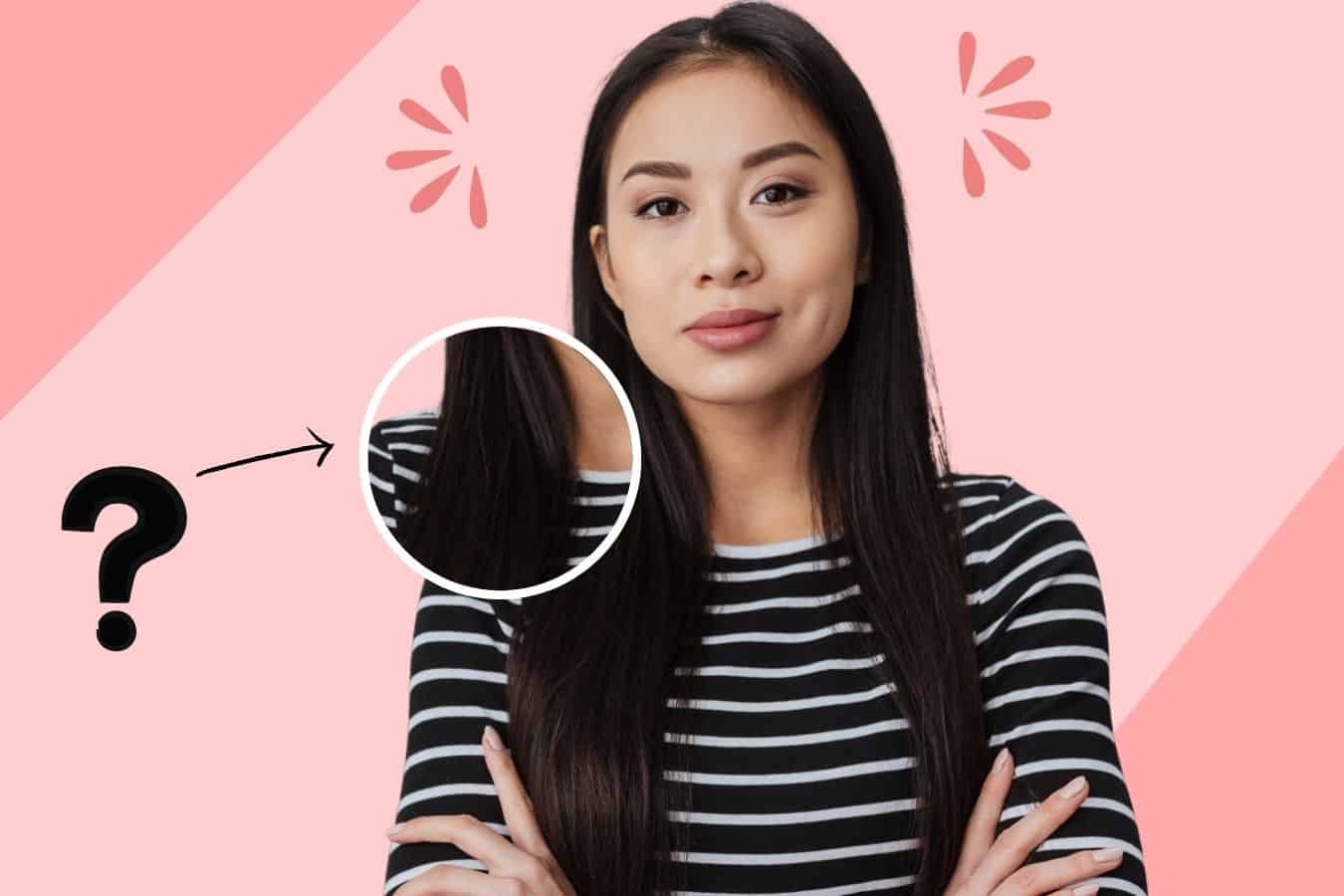Asian hair is often thought of as being strong and healthy, a characteristic of low porosity hair. In this article, we reveal whether Asian hair is in fact low porosity and give you tips on you how to best care for your Asian hair.

This post contains affiliate links and we may earn if you click on them (at no extra cost to you). Please read our full disclosure policy here.
Is Asian Hair Low Porosity?
Asian hair isn’t necessarily low porosity even though it has the stereotype of being long, shiny, and straight. It would make it an ideal candidate for low porosity. But in reality, Asian hair is not that one-dimensional and can run the length of the spectrum from high to low porosity.
Now you may know that hair can be classed into three broad ethnic group categories: Asian, African and Caucasian.
Let’s look at the typical characteristics of Asian hair (whether low porosity or not):
- Asian hair is relatively straighter than African or Caucasian hair.
- The color of Asian hair tends to be dark brown or black
- Grows perpendicular to the scalp. This is why shorter Asian hair often sticks straight up.
- Asian hair is the fastest-growing of all the groups, at a rate of 1.4 cm a month.
- The strand of Asian hair has an even, round cross-section when seen under a microscope.
- The cuticle layer is thicker than Caucasian hair with more tightly packed cuticle cells.
- Asian hair is the strongest of the three types. It can endure the most stress, strain, and stretching when compared to African and Caucasian hair types.
So, the stereotype of long, straight, shiny Asian hair does ring true in many cases. Such hair suggests low porosity.
But it is not necessarily always the case. It’s worth bearing in mind that there are variables, which will depend on your particular genetics and also the condition and treatment of your hair.
If your hair has undergone a lot of chemical or heat treatments, for example, it may have higher porosity.
What Exactly Is Hair Porosity?
Hair porosity is the ability of your hair to absorb and retain moisture.
The porosity of your hair depends mostly on genetic factors, but it can also be influenced by other factors.
For example, heat treatments and chemical processing can cause your hair to have higher porosity.
Porosity falls into three categories:
High Porosity
If you have high porosity hair, it is able to absorb moisture quickly, but it can lose moisture just as rapidly.
You may have high porosity hair due to genetics, or it could be due to chemical or heat damage.
The characteristics of high porosity hair are:
- Tends to be dry
- Prone to frizz
- Breaks easily
- Air dries quickly
- Tends to look dull and lacks shine
- Absorbs products quickly
Medium Porosity
Medium porosity hair is common in many Caucasian people.
As the name suggests, the porosity of this hair type sits in the middle of two extremes.
Characteristics of medium porosity hair are:
- Relatively low maintenance. Hair usually looks shiny and healthy
- Tends to be relatively easy to style and holds styles well
- Perming and dying produce predictable results. However, performing these processes frequently can still damage the hair and result in it having higher porosity
- A wide variety of products can be used for different results
- Will get slightly frizzy when exposed to humidity
Low Porosity Hair
Low porosity hair does not absorb moisture easily. This is because the cuticles of the hair overlap and are tightly packed, like shingles on a roof.
The characteristics of Asian hair thus suggest it has low porosity.
Low porosity hair has some telltale signs:
- It takes ages to get soaked and water droplets roll off it initially in the shower.
- It takes ages to dry. When it finally is wet, it retains water like crazy.
- Products don’t absorb. Can be prone to product buildup.
- Resistant to chemical processes. Hair is resistant to bleaching, dyes, and perming.
Also read: Does Low Porosity Hair Need Protein? (How To Tell)
How To Know The Porosity Of Your Hair

The characteristics of the different hair porosity types listed above should give you an idea of what your hair porosity is.
But if you want to be more certain, you could try one of these simple tests:
The Texture Test
To perform the Texture Test, simply take a strand of your hair and feel along the strand with your fingers.
If it feels bumpy at all, this suggests raised cuticles, which means you may have medium or high porosity hair (the bumpier it feels, the higher the porosity).
If your fingers glide smoothly along the hair strand, this means you have low porosity hair.
The Strand Test
Clean hair will give you the most accurate results for the Strand Test, so firstly shampoo and rinse your hair thoroughly to remove product build-up. Then dry your hair as usual.
Pluck a single strand of hair from your head and drop it into a glass of water. Observe the hair strand to see where it floats.
If the hair sinks to the bottom of the glass fairly quickly, this is a sign it is more porous. Therefore, it has high porosity.
If the hair floats near the middle of the glass it is likely medium porosity.
If the hair floats at the top of the glass for a while before sinking to the bottom, it’s likely it has low porosity.
How To Care For Low Porosity Hair

Irrespective of what ethnic group your hair fits into, whether Asian or otherwise, much of the effectiveness of the products you use will depend on your hair’s porosity.
Whether it is low, medium, or high porosity, below we’ve compiled some hair care tips for each of the three categories.
1. Use shampoo to clarify your hair
Wash your hair once a week with a clarifying shampoo to get rid of build-up, oil, and dirt. Some hair types find clarifying shampoos too harsh but Asian hair is very strong and can withstand the effects of the chemicals.
If your hair doesn’t get too oily, dry shampoo may work really well. Check out this list of dry shampoos for Asian hair.
2. Use heat to get moisture into the hair
By this, we mean using heat caps and hooded dryers while using deep conditioning treatments.
Use a heat cap that uses flaxseeds to speed up the heating process. Adding heat will help to open your hair’s cuticles and get that moisture in.
Then use cold water to rinse the hair and seal the cuticles, preventing frizz.
3. Avoid protein treatments
These will only make the outer cuticle of the hair stronger, which you really don’t need. It will only make your hair more resistant to moisture.
4. Use humectants
Humectants are substances used to preserve moisture. Common humectants used in hair care are glycerin and honey.
Note that if you live in very humid areas it’s best to avoid glycerin products as they can draw too much moisture from the air.
This could potentially cause frizz. Instead, try using a glycerin-free hair product.
5. Avoid heavy oils and heavy products
These will just sit on the hair, causing product buildup.
Instead, use lighter, liquid products, such as hair milk, or lighter oils, like Argan and black seed oil, that won’t leave your hair greasy.
You can even try deep conditioners specifically formulated for low-porosity hair.
Also, try adding water to your conditioner before applying it. The lighter texture will help it absorb into your hair more easily.
How To Care For Medium Porosity Hair
1. Use natural products
You can experiment with a range of products, but you don’t need to go overboard with the heavier conditioner. Shea butter, vitamin E oil, and Jojoba Oil are all especially good.
2. Occasional deep conditioning is good for your hair
Use a deep conditioner once every 10 days to hydrate your hair. Go for conditioners that are free from parabens and silicones to encourage your scalp to produce its own natural oils.
3. Protein treatments are good for occasional
Protein treatments can help restore damaged hair and can be an excellent addition to your hair care routine. However, if you have very stringy, dry hair, try a hydration deep conditioner first.
You should also avoid using protein treatments too often.
4. Avoid heat
Maintain your hair’s health by staying away from excessive heat styling and chemical processes. Otherwise, your hair could end up with higher porosity.
Wash hair regularly to remove build-up of natural oils and product build-up.
How To Care For High Porosity Hair
1. Use protein treatments for your hair
High porosity hair needs protein to rebuild the bonds within the cuticle.
A favorite is the Olaplex Hair Perfector No 3 Repairing Treatment. Your hair cuticle needs to be strengthened and this is where protein treatments come in.
Use once or twice a month for best results.
2. Regular deep conditioning
A regular deep condition is a great idea for high porosity hair. Even after every wash, if your hair needs it.
3. Go easy on the heat styling
Using too much high heat will dry and damage your hair and make it more brittle. Try opting for hairstyles that embrace your natural texture, using low heat or low heat.
4. Use heavier products with butter or oils
These will help seal in the moisture. Look for ingredients like Shea butter, olive oil, or avocado oil. Try leaving in shea butter overnight for a deep treatment.
5. Opt for products free of silicones, sulfates, parabens, and phthalates
We would usually encourage this anyway, but it’s especially important if your hair is high porosity as these ingredients strip your hair of natural moisture.
Instead, opt for products full of natural and organic ingredients.
So, there you have it. We hope these tips help you to make your hair feel and look as good as it possibly can.
Do you have Asian or low porosity hair? Do you have any suggestions we haven’t mentioned? Let us know in the comments!
Disclaimer: This site is not intended to provide professional or medical advice. All of the content on LovedByCurls.com is for informational purposes only. All advice should be followed at your own discretion. Ingredients may change at any time so always check the product label before using. Check our full disclaimer policy here.
